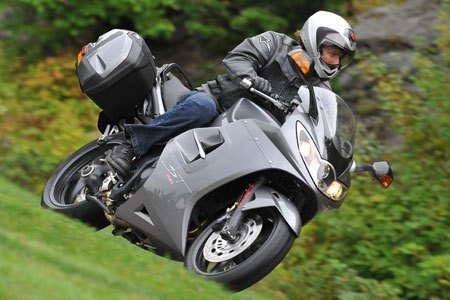2009 Triumph Sprint ST Review - Motorcycle.com
We’re spoiled rotten ‘round here, riding only the latest two wheelers to come down the pipe. With so many new bikes to choose from all the time it’s easy to get jaded.
“Bah! I’m tired of the color of this one. Bring a new motorcycle!”
And when we’re talking about highly competitive market segments like sportbikes or sport-touring sleds, the need to feed the new bike addiction only gets worse.
With traction control and advanced linked ABS (and various other touring amenities) now making their way to bikes like the new 2010 Kawasaki Concours, our appetites seemingly become more difficult to satiate each new model year.
That’s too bad, as there’s often a bike or two that doesn’t shift with the winds of change quite as fast as it competitors but is nevertheless still an excellent option.
One such bike is Triumph’s Sprint ST.
Although the ST doesn’t offer a bunch of techy options like some type of traction control or rider-selectable ABS, it has seen a number of minor but important running updates following its 2005 major revamp.
During that year, one of the most significant updates was the big in-line Triple getting even bigger, graduating from 955cc to the current 1,050cc by way of increased stroke. Also key to the overhaul in ’05 was optional ABS.
Here’s a brief look at the updates, not including the big changes in 2005 and no revisions in 2009/10:
| Updates and Revisions to Triumph Sprint ST |
| 2006 |
| • Insulating washers added under passenger grab handle to reduce the heat transmitted to the handle |
| • Improved heat shielding in both side fairings to reduce heat on riders’ legs |
| 2007 |
| • Saddlebags as standard |
| • Seat re-shaped to make it easier for riders put a foot down; 31.7-inch seat height remains in 2010 |
| • Revised exhaust system for Euro 3 emissions with improved catalyst in a new location |
| • Revised EFI calibration to go with Euro 3 exhaust system |
| 2008 |
| • Redesigned projector units in the headlamps to increase sign light (i.e. the light bleed into the dark areas that illuminates reflective surfaces) |
| • Tall screen and higher handlebars |
| • Steel fuel tank replaced plastic fuel tank |
Hard to believe, but we last put some serious miles on the ST almost three years ago in our 2006 Sport-Touring comparison. The chance to ride the ST as one of the test mules during the Pirelli Angel ST tire launch in September of this year was a good opportunity to reacquaint myself with the sporting English tourer, and sample useful updates like the higher bars, a taller windscreen and improved EFI.
Levering the ST off its sidestand reminds the rider this isn’t the sporty Daytona 675, as the majority of the ST’s claimed 530 lbs wet weight feels like it rides high. At a standstill, teetering the bike side to side between your legs, you can feel the weight carry the bike quickly to either side.
However, even if the ST gains a few pounds in real world weights over claimed figures, it’s still right in line with Honda’s Interceptor (VFR 800) that Big Red purports to weigh 540 lbs fueled and ready to ride. And the new VFR1200F is reportedly scaling in at 589 lbs with all fluids and a tank full. Despite not changing dramatically in over five years, the Sprint ST is still competitive in this area. Measure the ST against others in the class, like the BMW K1300GT (635 lbs curb weight) and Concours (670 lbs curb weight), and it¹s almost a lightweight.
Once under way, the sensation of a tall center of gravity melts away, and an easy handling, neutral steering Sprint ST is revealed; even at low speeds. Initial turn in may not be as light and feathery as, say, the K1300GT, but once set in for the turn, the Sprint shines with a solid, planted feel, as if nothing other than the rider’s will can move the bike off its intended path. At interstate speeds the chassis is equally unflappable, and the suspension is supple yet stable.
The Sprint’s steering geometry is still competitive and allows it to run with the new kids on the block. A 57.3-inch wheelbase and 24.0 degree rake/3.5 inches of trail combo is notably edgier than the VFR1200F’s 60.8-inch wheelbase and 25.5 degrees of rake. Heck, even the Interceptor 800’s 57.4-inch spread and 25.3 degrees is closer than the new VFR is to Ol’ Man Sprint!
Fueling is about as smooth and crisp as anything available today, allowing the rider to dial in all that über-linear in-line Triple power that’s transmitted seamlessly through the light action clutch and six-speed gearbox. The Triple's user-friendly power is complemented by the wonderfully raspy exhaust note burbling from underneath the seat as it exits the still-stylish exhaust tips in triplicate.
In our 2006 sport-tourer test most of us thought the ST was cozy and accommodating. Things only seem to have improved. The comfortable but supportive saddle lets a 30-inch inseam easily touch down with at least one foot, and reach to the now taller bars makes for an even friendlier rider triangle, yet the sense of a sporting steed isn’t diminished.
Who better than the English to know wet weather, right?
Triumph has a fairly comprehensive line of riding gear. One of the more versatile items is the H2Protec Jacket.
The 1.2mm leather jacket aspires to be a Swiss Army Knife of riding gear, doing it all, as it boasts being waterproof, windproof and yet breathable. It has removable CE shoulder and elbow armor, double stitched impact seams, a removable thermal liner, copious pockets and various ventilation points. But perhaps as trick as the waterproofing of the leather is what’s called TFL heat reflective treatment.
This “cool” technology leather treatment adds dyes and pigments to the leather to make UV/infrared rays from the sun “see” the dark leather as a lighter color. As you may recall from your elementary school studies, lighter colors reflect heat, while dark colors absorb it.
A cold, rainy three hour ride wasn’t the ideal testing grounds to see if the TFL treatment would reduce the jacket’s surface temp by up to 20 degrees and thereby the internal temp up to 12 degrees, as Triumph materials claim. But the miserable riding weather experienced during the Pirelli Angel ST tire review was spot on for checking the leather’s waterproofing.
Though I’m sorry to say I rode in the rain for hours, I’m ecstatic to report H2Protect kept me entirely dry, and more importantly, warm!
The size medium I sampled was roomier than most mediums in various brands of leather I’ve worn, but it wasn’t so big as to be clumsy or ill fitting. Part of the loose fit is what Triumph calls the Comfort fit. This cut was developed with the cruiser rider in mind, with a wider cut at the shoulders, deeper armholes and “more generous torso proportions.” Hmm… Time to up my daily beer intake to capitalize on this style.
I’d like to see some additional snaps or Velcro on the neck closure to help snug up the fit and further seal out the weather, but it’s not like rain water was streaming in through the collar. Still, if you want the extra protection, an optional fleece neck warmer is available.
Beyond that, the only potential drawback is the additional weight gain from water retention. Although I was bone dry after the long, wet ride, the jacket was noticeably heavier. And, like most wet leather, some of the dye can bleed off as I found out firsthand after a couple hours drying time in the closet when the jacket brushed up against the hotel’s gleaming white terry cloth robes. Oops!
The H2Protec Jacket is available in sizes Small to XXX Large and retails for $519.00. A matching pair of pants called the H2Protec Jeans are available with all the same treatments the jacket gets, and they can be zippered to the jacket. The Jeans are available in waist sizes 30 to 42 and retail for $369.99.
The instrument panel, though unchanged for some time, still provides all the essentials at a glance. A tach is in the center of the three-ring package, with a easily read LCD to the right, and speedo on the left.
Braking power is plentiful and easily modulated. And when ABS activates it does so with limited feedback (pulsing).
Though tackling the heat management issue was one of the first orders of business for Triumph years ago, I still detected heat making its way to my shins, even in the cool, damp riding conditions experienced on ride day. This, however, is one of the few bones of contention on an otherwise well-sorted motorcycle.
The Sprint ST’s claimed 123 bhp and 76 ft-lbs may be near the bottom of the class these days in the competitive S-T segment, with Honda’s new VFR1200F allegedly producing 167 ponies at the crank. And the K1300GT we dyno tested in our 2009 Sport-Touring Shootout managed a class-crushing 145 hp! If nothing else changes for 2010 this will have the Sprint likely falling between the Honda ST1300 that dyno’d about 105 ponies and the FJR’s 119 hp in this year’s shootout.
Though billed as part of the sport-touring class, the Sprint doesn’t offer touring amenities like electronically adjustable windshields, heated grips and seats, or any number of push-button gadgets that grace other machines. The Sprint is much better aligned with the sport side of the S-T equation; therefore its nearest competitors are the Honda Viffers.
But if you’re still tempted by all the new stuff on the market, then perhaps the Triumph’s bargain basement $11,999 MSRP, or $12,799 with ABS, will keep your eyes from wandering. The new standard model VFR1200F’s MSRP is anticipated to reach upwards of 15 big ones, with the dual-clutch VFR possibly pushing well past that price, especially when adding optional hardbags, heated grips, etc.
The new VFR is bound to leave the ST eating dust in terms of sheer power. But the Sprint’s hallmark isn’t big numbers. It’s an especially tractable powerband, rock-solid handling, an unmistakable exhaust note, long day ergos and British heritage that best characterize the ST after all these years. Despite being an old man of the group, the Triumph Sprint ST is still a player.
Related Reading
2010 Honda VFR1200F Review
2010 Kawasaki Concours 14 Review
2009 Sport-Touring Shootout
2006 Sport-Touring Shootout
2008 Triumph Urban Sports Review
All Things Triumph on Motorcycle.com
Sport-Touring Reviews on Motorcycle.com
More by Pete Brissette



































Comments
Join the conversation